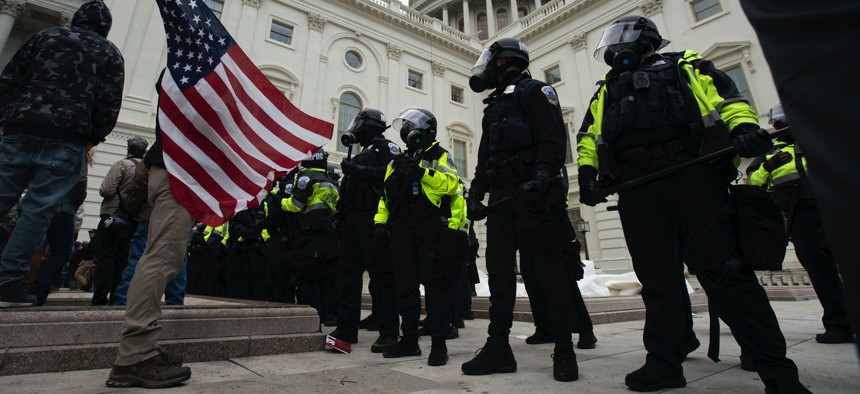
U.S. Capitol Police officers push back demonstrators who were trying to break into the U.S. Capitol on Wednesday, Jan. 6, 2021, in Washington. AP / Jose Luis Magana
Riots Shine Light on ‘Infamously Opaque’ Capitol Police
The 193-year old agency has a large budget and workforce, but lacks transparency mechanisms.
The violent pro-Trump protests at the U.S. Capitol on Wednesday thrust the Capitol Police into the spotlight. But getting to the bottom of why the relatively large, well-funded force failed to stop rioters from entering and desecrating the Capitol building and why the force reportedly rejected offers for help ahead of time could be difficult, because the agency has historically not been transparent about its operations.
The Capitol Police was established in 1828 to protect members of Congress as well as congressional visitors, employees and buildings. It is overseen by a board, which includes the chief of police, House Sergeant-At-Arms, Senate-At-Arms, and Architect of the Capitol. The first three are resigning in the wake of Wednesday's events.
“The little-known department has a budget that exceeds $515 million for fiscal 2021— constituting almost 10% of legislative branch funding — and nearly 2,450 employees, around 2,000 of whom are sworn officers,” said a report by Amelia Strauss and Daniel Schuman from Demand Progress, a grassroots organization that advocates for modernization and accountability in government, published on Wednesday night. Its “budget can compete with major municipal police forces" and its "workforce size eclipses that of major city departments like New Orleans and Miami. Notably, their extended jurisdiction covers less than 2 miles, and there are many other police and security forces in Washington, D.C.”
Over the last two years, the majority of the incidents the Capitol Police reported were traffic stops, and most of the department’s policing activities occurred when Congress finished work for the day. Only a third of arrests happened on the immediate campus of the Capitol, according to Demand Progress’ analysis.
Capitol Police Inspector General Michael Bolton testified during a hearing in July 2019 that a “major challenge” for the force is “protecting and securing the Capitol complex from terrorists and weapons of mass destruction, while at the same time protecting Congress and its staff and welcoming the public.” It “faces the challenge of coordinating programs for protecting people, facilities and information,” as is the case with other federal agencies.
“Capitol Police are infamously opaque,” Strauss and Schuman wrote. “Insufficient accountability mechanisms” could be one of the reasons the force wasn’t prepared for Wednesday. Gus Papathanasiou, chairman of the Capitol Police Labor Committee, testified during the July 2019 hearing that the department’s lack of transparency has spanned multiple presidential administrations.
Although the Capitol Police has an IG, who is a member of the Council of the Inspectors General on Integrity and Efficiency, the watchdog’s reports are not made public. Also, the department is exempt from having to release information under the Freedom of Information Act.
The fiscal 2021 spending bills enacted late last month included some provisions to improve the agency such as: establishing a FOIA-like protocol to share information, creating a review process to make some IG reports public, requiring arrest information to be published with thorough details, and enacting several measures to address racism and diversity issues in the force.
These are “welcome” changes, said Strauss and Schuman, but “were not implemented in time to provide insight into USCP operations.”
Besides carrying out those provisions, some of the agency’s goals for 2021-2025––which carry additional significance now––are to further invest in its workforce, “strengthen emergency readiness and the ability to continue operations during potential crisis situations,” bolster information gathering abilities and enhance department transparency and accountability, as outlined in a report.
The force will also be dealing with several congressional and Justice Department investigations on the riots and protecting a more vulnerable Capitol now.
“The USCP is conducting a thorough review of this incident, security planning and policies and procedures,” Chief of Police Steven Sund said in a statement before the news broke about his resignation. “The actions of the USCP officers were heroic given the situation they faced, and I continue to have tremendous respect in the professionalism and dedication of the women and men of the United States Capitol Police.”




